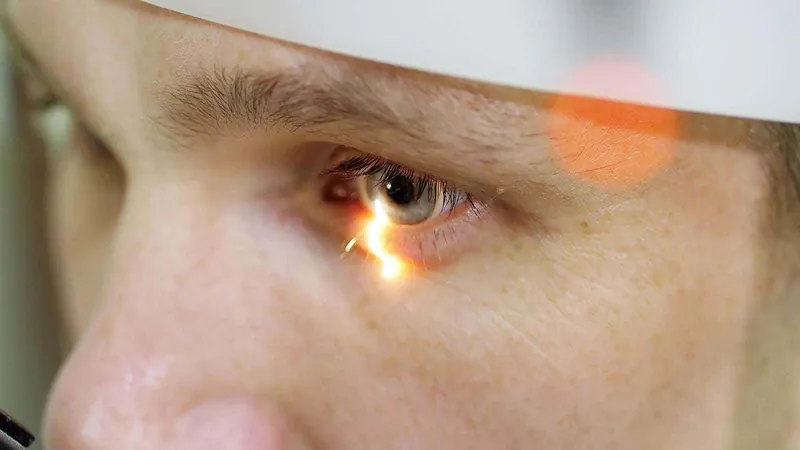
Groundbreaking Study Reveals Hidden Vision Issues in Mild Traumatic Brain Injury Patients
2024-11-27
Author: Li
Introduction
A recent study has unveiled astonishing insights into the vision problems faced by individuals suffering from chronic mild traumatic brain injury (TBI). Using advanced optical assessments and innovative machine-learning technology, researchers have discovered that comprehensive workups can uncover typically overlooked vision deficiencies in this patient population.
Study Overview
Conducted by Tonia S. Rex, PhD, from the Vanderbilt Eye Institute, the study examined 28 participants who had experienced a mild TBI an average of six years prior. The findings were striking: the participants showed significant reductions in their ability to converge visual images and demonstrated decreased sensitivity to contrast. Specifically, the prism convergence test revealed a marked decrement in breakpoint, with a reduction of -8.38 (95% CI -14.14 to -2.62, P=0.008) and recovery point (-8.44, 95% CI -13.82 to -3.06, P=0.004), indicating substantial oculomotor deficits.
Complexity of Diagnosis
Dr. Rex highlighted the complexity of diagnosing TBI-related vision problems, emphasizing the necessity for multimodal diagnostic approaches. "We hope that by combining various tests with machine-learning algorithms, we can develop a reliable diagnostic tool for these patients in the future," she stated.
Significance of Research
The implications of this research are significant, particularly given that approximately 4 million people in the U.S. experience TBIs annually, with about 75% classified as mild. Alarmingly, around 80% of TBI patients report vision-related issues, such as difficulties in reading and increased sensitivity to light. Despite these challenges, current clinical pathways fail to adequately address oculomotor function, leading to misdiagnoses or overlooked vision problems.
Challenges in Current Clinical Practices
Dr. Rex has encountered many patients who sought help from eye care professionals only to be told their vision was normal, often resulting in referrals to mental health specialists instead of addressing the real issue. She asserts the urgent need for a shift in how TBI-related vision issues are diagnosed and managed.
Standardized Testing Protocols
Currently, there is no standardized testing protocol for vision problems linked to TBI. Dr. Rex and her team are working toward establishing a comprehensive battery of tests to better diagnose and treat these patients. In the meantime, she recommends standardized assessments by trained orthoptists to capture and monitor visual deficits accurately.
Severe Complications
The study also shed light on more severe complications, such as damage to the retina, optic nerve, and brain, which may not be detectable through routine examinations. Dr. Rex's lab is currently exploring neuroprotective and neuroregenerative strategies to combat such damage.
Additional Insights
The work received additional commentary from Madeleine K. Nowak, PhD, who noted that while the ideal testing battery remains undecided, expanding the typical eye exam to include advanced imaging techniques like optical coherence tomography (OCT) and MRI, along with machine learning analysis, could enhance the detection of neurophysiological damage.
Considerations for Future Research
However, it's crucial to address that the study excluded individuals with previous neurological or psychiatric conditions, which can also contribute to visual disturbances. Future research must consider how these factors interact with vision impairments resulting from mild TBI.
Conclusion
The study, which took place between May 2018 and November 2021, included a well-defined cohort of 28 mild TBI patients and a matched control group. Participants underwent a series of comprehensive assessments, revealing notable reductions in retinal nerve fiber thickness and changes in the optic nerve and brain structure. While this study has opened new pathways in our understanding of TBI-related vision problems, researchers emphasized that further investigations are vital to establish a clear connection between mild TBI and the array of visual dysfunctions identified. The road ahead promises to be as complex as the injuries themselves, but with continued research, the hope is that effective diagnostic and treatment options will soon be available to this underserved patient population.



 Brasil (PT)
Brasil (PT)
 Canada (EN)
Canada (EN)
 Chile (ES)
Chile (ES)
 España (ES)
España (ES)
 France (FR)
France (FR)
 Hong Kong (EN)
Hong Kong (EN)
 Italia (IT)
Italia (IT)
 日本 (JA)
日本 (JA)
 Magyarország (HU)
Magyarország (HU)
 Norge (NO)
Norge (NO)
 Polska (PL)
Polska (PL)
 Schweiz (DE)
Schweiz (DE)
 Singapore (EN)
Singapore (EN)
 Sverige (SV)
Sverige (SV)
 Suomi (FI)
Suomi (FI)
 Türkiye (TR)
Türkiye (TR)